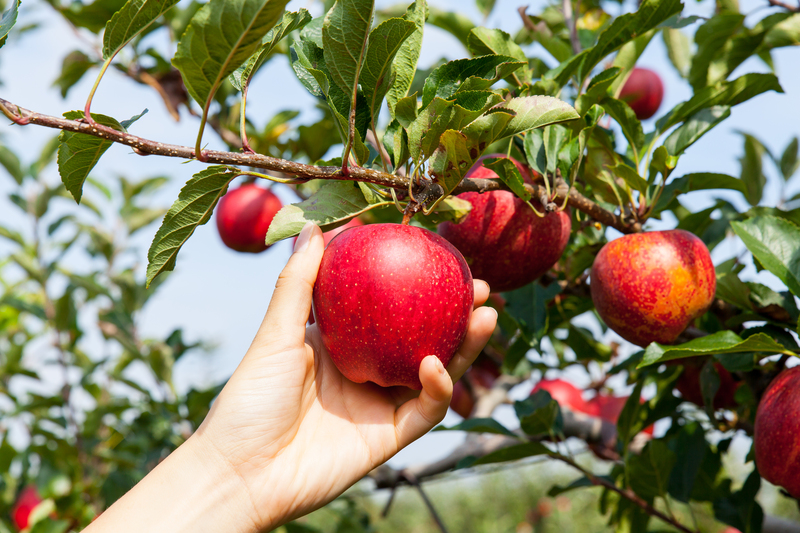Crafting a Garden That Thrives Despite Windy Weather
Posted on 26/06/2025
Crafting a Garden That Thrives Despite Windy Weather
Gardening is a beloved hobby that brings both beauty and bounty to outdoor spaces. However, for those who live in windy areas, establishing a thriving garden poses unique challenges. Fierce gusts can flatten flowers, spread diseases, dry out soil, and damage delicate plants. But don't despair! With the right strategies, you can create a lush, healthy outdoor oasis that not only endures harsh winds but flourishes because of them. In this guide, we'll explore practical, research-backed steps for crafting a garden that thrives despite windy weather.
Understanding Wind and Its Impact on Your Garden
Before planting your first seed or bush, it's crucial to understand how wind affects your garden environment. Windy conditions can create both direct and indirect stress on plants. Here's how:
- Mechanical Damage: High winds can break stems, snap branches, and tear leaves.
- Desiccation: Constant air movement removes moisture from both soil and plant tissues, causing wilting and dehydration.
- Temperature Fluctuations: Wind can lower temperatures around your plants, chilling sensitive species and slowing growth.
- Pollination Disruption: Wind may damage blossoms or blow away pollen before it can settle.
- Soil Erosion and Nutrient Loss: Gusts can strip topsoil, exposing roots and washing away essential nutrients.
Understanding these effects is the first step towards designing a resilient, wind-friendly garden.

Smart Garden Design for Windy Places
One of the keys to successful wind-resistant gardening is thoughtful design. By planning ahead, you can harness natural windbreaks, create microclimates, and limit exposure.
Assessing Wind Patterns
Observe your yard to determine the direction and strength of prevailing winds throughout the year. Wind often funnels between structures or over hills, creating "wind tunnels" where plants suffer the most damage. Take time to map these patterns for more strategic planting.
Strategic Placement: Use Nature and Structures
- Plant Near Fences and Walls: Solid barriers can deflect wind and cast some protection over your garden beds.
- Utilize Existing Vegetation: Tall trees, thick hedges, and thickets serve as natural shields, reducing wind speed as it passes through.
- Shape Your Garden Layout: Arrange tall or fragile plants behind windbreaks or on the leeward side of the house.
- Cluster Plantings: Grouping plants closer together helps reduce individual stress and creates a collective buffer against wind.
Building Effective Windbreaks
One of the most important strategies for crafting a garden that thrives despite strong wind is the construction of windbreaks. These can dramatically reduce wind speed and create safe microclimates for vulnerable plants.
Types of Windbreaks
- Living Windbreaks: Hedges of dense shrubs, evergreens, or closely-planted trees function well. Good choices include yew, boxwood, privet, cedar, or holly.
- Artificial Windbreaks: Fences, trellis screens, or even woven willow panels can serve as quick fixes.
Tip: For best effect, your windbreak should be at least as tall as the plants you want to protect and extend wider than the area you're sheltering. A windbreak that is porously constructed (such as a row of shrubs or a slatted fence) works better than a solid wall, which can cause wind to swoop over and create turbulence behind it.
How to Plant a Shelterbelt
- Select Diverse Species: Use a mix of evergreen and deciduous plants to ensure year-round protection.
- Stagger Rows: Plant in several offset rows for maximum protection.
- Allow Space: Don't crowd the windbreak, which prevents healthy growth and proper wind diffusion.
A well-designed windbreak can reduce wind speeds by up to 50 percent for a distance of up to ten times its height!
Choosing Plants That Can Withstand the Wind
Another essential factor for successful gardening in windy conditions is choosing the right plants. Some species are inherently tougher and better adapted to breezy sites.
Top Wind-Tolerant Trees and Shrubs
- Pine (Pinus): Flexible and sturdy, pines withstand strong winds.
- Hawthorn (Crataegus): Tough and resilient with dense habit.
- Russian Olive (Elaeagnus angustifolia): Drought- and wind-tolerant.
- Sea Buckthorn (Hippophae rhamnoides): Perfect for coastal, windy gardens.
- Griselinia littoralis: A top choice for windbreaks in milder climates.
Best Wind-Resistant Perennials and Groundcovers
- Lavender: Woody stems and flexible foliage handle wind beautifully.
- Sedum: Thick leaves protect against desiccation.
- Carex and Festuca (Ornamental Grasses): Naturally adapted to movement.
- Daylilies (Hemerocallis): Robust and low-maintenance.
- Vinca minor: Dense mat formation shields the soil.
Tips for Plant Selection
- Choose Low-Growing Plants: Plants with less height present less surface area to wind.
- Select Flexible-Stemmed Varieties: These bend instead of snapping in strong gusts.
- Opt for Deep Roots: Deep-rooted species anchor better and resist being uprooted.
By paying close attention to the natural resilience of your chosen plants, you're stacking the odds of gardening success in your favor!
Soil Management for Windy Gardens
Windy weather gardens often suffer from parched or eroded soils. Maintaining healthy, structured soil is vital for resilient plants.
Minimize Erosion
- Mulch Generously: Apply a thick layer of organic mulch (bark, straw, compost). This protects the soil surface from direct wind and conserves moisture.
- Use Ground Covers: Dense, low-growing plants like creeping thyme or ajuga act as living mulch and hold soil in place.
- Install Edging: Flexible edging or even rows of rocks can help stop soil from blowing away at bed margins.
Improve Soil Structure
- Incorporate Compost: Regular additions of compost increase soil's ability to hold water, even when the wind dries the surface.
- Avoid Overcultivation: Minimize digging or raking, as this breaks down soil structure and exposes it to more erosion.
*A healthy soil foundation ensures that your plants can withstand tough weather conditions and recover faster from wind exposure.*
Watering Techniques in Exposed Gardens
Wind quickly strips moisture from soil and plant leaves, making smart irrigation a must in exposed gardens.
Water Wisely
- Use Drip Irrigation: Drip or soaker systems deliver water directly to plant roots, minimizing evaporation and fungal risk caused by wet leaves in breezy air.
- Water Early in the Day: Allows foliage to dry before the cold night and reduces water loss in wind.
- Check Soil Moisture Regularly: The top layer may look dry, but deeper soil could still be damp. Dig in to check before watering.
Mulching for Water Conservation
- Organic Mulch: Bark chips, leaf mold, or even gravel help retain soil moisture and buffer against wind-borne evaporation.
Conserving water is especially important in gardens where wind is a daily occurrence.
Supporting Plants Against Wind Damage
Even with smart design and hardy species, some of your plants may still need a helping hand.
Staking and Support
- Use Stakes Wisely: For young trees or tall perennials, use flexible ties and support systems that allow the plant to sway--this builds strength while providing security.
- Cages and Grids: Tomato cages, mesh grids, or homemade supports help keep larger blooms upright without being too rigid.
Pruning and Maintenance
- Prune Regularly: Thin out dense canopies. This reduces wind resistance and the chance of breakage.
- Remove Dead or Damaged Growth: Weak branches are more likely to become casualties during storms.
Don't forget to check supports and ties regularly, especially after major wind events.
Extra Protection for Tender Plants
For the most delicate species, sometimes a little extra help is needed--especially during establishment or severe weather.
- Cloche and Row Covers: Temporary plant covers shield young seedlings.
- Shade Cloth: Can also act as a modest windbreak around veggie beds or herbs.
- Move Containers: If you garden in pots, cluster them together and move to a sheltered spot during storms.
Sometimes, a little intervention can prevent a season's worth of effort from being undone by a single gale!
Wind-Resilient Vegetable Gardening Tips
If you dream of homegrown vegetables despite the wind, the following tips will be invaluable:
- Start Indoors: Give plants extra time to grow sturdy stems before transplanting outside.
- Use Raised Beds: Raises soil level and allows for better drainage and quicker soil warming.
- Choose Wind-Tough Veggies: Kale, chard, carrots, and onions are good options for wind-exposed gardens.
- Install Removable Windbreaks: Simple mesh netting or temporary screening protects during the windiest months.
Creating Shelter for Pollinators
Wind can disrupt pollinators. Plant nectar-rich flowers on the leeward side or use rocks and garden art to create landing spots for bees and butterflies.

Final Thoughts: Embracing the Winds in Your Garden
Crafting a garden that thrives despite windy weather is all about working with, not against, Mother Nature. With proper design, plant selection, soil care, and smart gardening practices, you can transform even the windiest plot into a sanctuary bursting with beauty, food, and life. Remember to:
- Study your site's wind patterns.
- Invest in effective windbreaks.
- Choose plants with wind resistance.
- Care for your soil and water efficiently.
- Support your plants as they grow.
Patience and observation are your best friends. Over time, your garden will not just survive the wind--it will thrive because of it!
Further Resources
- Royal Horticultural Society: Windy gardens
- Gardeners' World: Best plants for windy gardens
- University Extension Services
Now, go out and start crafting your own windproof garden haven!

